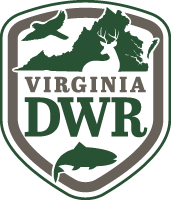
Dr. Jen Riley (left) and a veterinary technician help a turkey vulture at the Blue Ridge Wildlife Center. Photo courtesy of the Blue Ridge Wildlife Center
By Ashley Stimpson
The May/June 2020 issue of Virginia Wildlife magazine includes the article “Rehabilitators Fill a Vital Role for Wildlife,” in which writer Ed Simmons, Jr., highlights the efforts that more than 300 rehabilitators and caregivers permitted by the Virginia Department of Wildlife Resources (DWR) make to successfully return rehabilitated wildlife to their natural habitat. In light of the changes brought by the coronavirus pandemic, we reached out to find out how some of those rehabilitators are dealing with restrictions.
Spring is always a busy time in the world of wildlife rehabilitation. Hibernators are emerging, eggs are hatching, and animals are hungry. Stormy weather upends nests, and housecats are on the prowl. Even during a normal year, the state’s wildlife hospitals rely heavily on an army of volunteers to feed and care for the spring’s seasonal surge in patients.
But this is no normal year. As the coronavirus pandemic and shelter-in-place restrictions continue, these facilities have had to make do with severely limited manpower and a dip in donor support. To complicate matters further, each has reported a significant increase in their caseload.
“I suspect people working from home are spending more time looking at and finding wildlife,” says Dr. Jen Riley, director of the Blue Ridge Wildlife Center (BRWC) in Boyce. As of late April, BRWC had experienced a 50 percent increase in patients compared to 2019.
“Everyone is outside doing yardwork with their pets in tow,” says Sabrina Garvin, Riley’s counterpart at Roanoke’s Southwest Virginia Wildlife Center (SVWC). “Lots of injured Eastern cottontail rabbits are coming in.”

Cottontail rabbit kits at the Blue Ridge Wildlife Center. Photo courtesy of the Blue Ridge Wildlife Center
To comply with strict social distancing requirements while caring for an unprecedented number of animals, staff and volunteers at Virginia’s wildlife centers have gotten creative, finding new ways to protect staff, utilize volunteers, engage the public, and save wildlife at the same time.
Shop and Chop
Since she retired from Virginia Western Community College in 2015, Sarah Martin has spent Mondays, Wednesdays, and Fridays at SVWC, preparing meals for the hospital’s diverse group of residents. The former math professor has gotten pretty good at knowing what each species prefers. “Birds like everything separate, like a pie chart. Squirrels like a tossed salad,” she explains. “Turtles love chopped tomatoes.”
Meal prep for a wide variety of predilections, levels of dexterity, and jaw sizes is a time-consuming affair and, luckily, one that can be done at home. During the outbreak, Martin is tackling her “shop and chop” days remotely. First, using gift cards donated to the Center, she visits the grocery store to stock up on fruit and vegetables: kale, collard greens, sweet potatoes, apples, blueberries, grapes, carrots and more. Martin estimates she spends the next seven hours or so in her kitchen, methodically slicing and dicing.

Sarah Martin drops off chopped fruits and vegetables to help feed the wildlife at Southwest Virginia Wildlife Center. Photo courtesy of the Southwest Virginia Wildlife Center
Everything is then packed into storage bags and taken to the Center, where it can be quickly divvied up at mealtime.
The work is gratifying for Martin, who feels good about “supporting something I love.” But it also helps her pass the time in quarantine. “Cutting a blueberry into eight pieces is very time-consuming,” she laughs.
(Animal) Shelter-in-Place
In mid-March, DWR Executive Director Ryan Brown signed an emergency order allowing permitted individuals to care for healthy mammals at home, significantly reducing the number of staff needed at each facility.
“A select handful of highly skilled volunteers are taking babies home,” said Dr. Riley. “So that those of us in the hospital can focus primarily on medical and surgical patients.”
One of the highly skilled volunteers to whom Riley has turned is Ashleigh Bohlman, a Front Royal resident and veterinary technician who happened to be in the process of obtaining her own wildlife rehabilitation permit when the pandemic began. Bohlman recently spent three weeks hand-feeding baby squirrels in her home’s dedicated rehab room. “It was really hard not to get attached; they are delightful,” she says. “But they are wild animals, and they belong in the wild.”
Bohlman has also been active in transporting patients to and from BRWC, including owls, hawks, and possums, by using a special drop-box located outside the Center where animals can be placed for pick-up or drop-off. “We are practicing social distancing by staying six feet apart outside of the building, wearing proper personal protective equipment, and limiting our interaction to a bare minimum,” she said.
Bohlman’s fellow volunteer, Kristi Titus, has been a home rehabber for four years, but this year, she says, her house is a “literal zoo.” So far, she’s cared for 30 possums, 32 squirrels, and one flying squirrel, while balancing her full-time job as an elementary school teacher (which she now does virtually). On weekdays, Titus gets up early for class and stays up late feeding animals but says sharing her home with them “makes me very, very happy.” She particularly enjoys watching the possums run on their exercise wheels.
Thinking Outside the Box—and the State
Staff at the Wildlife Center of Virginia (WCV) in Waynesboro are also coping with a record number of patients while implementing strict no-contact policies and sanitation measures. According to WCV President Ed Clark, since the outbreak began the hospital has been off-limits to anyone who doesn’t need to be there—including himself (he’s working remotely). Clark’s staff has been divided into two teams that never overlap and who stay in touch via Discord, a platform popular with video game enthusiasts.
As one of America’s leading wildlife teaching hospitals, staff at WCV have also been hard at work figuring out how they can help other rehabilitation centers around the country.
“We don’t just want to exemplify high standards—we want to help others do the same,” says Clark. That has meant working closely with DWR on March’s emergency order as well as with the U.S. Fish and Wildlife Service to explore if the helpful policies enacted in Virginia can be adopted in other states.
WCV has also developed and posted a series of videos detailing how wildlife hospitals can and should respond to the COVID-19 outbreak. These videos address everything from those special permit conditions to maintaining public outreach in a time of social distancing.
Like the other wildlife hospitals in Virginia, WCV has ramped up its online offerings—virtual book clubs, Facebook Live events, and livestreams from animal enclosures—to stay connected with animal lovers, homeschoolers, and donors for as long as the pandemic lasts.
 Make sure to read the May/June 2020 issue of Virginia Wildlife magazine to learn more about how permitted wildlife rehabilitators serve Virginia’s wildlife.
Make sure to read the May/June 2020 issue of Virginia Wildlife magazine to learn more about how permitted wildlife rehabilitators serve Virginia’s wildlife.


